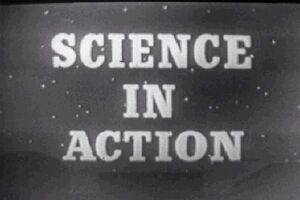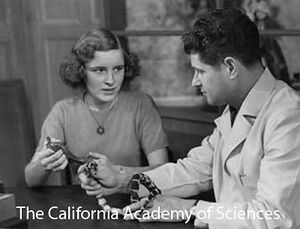Series:Science in Action
Science in Action is a series that ran from 1952 to 1966, produced by the California Academy of Sciences in Golden Gate Park, San Francisco.
The series began in 1950 as a popular 15-minute segment on a popular Bay Area television program, The Del Courtney Show. Tom Groody discussed scientific topics and animals. Eventually, Groody’s Science in Action segment became a regular 13-week feature on the program, presenting contemporary science issues.
Installments
- 029 Science in Action - Termites (1954?)
- 035 Science in Action - PLANTS and Fairyland ()
- 079 Science in Action - Powerful Poisons (1953)
- 101 How Man Measures (1954) - The concept of measuring distances is very ancient although the methods devised by man in every civilization were crude. Yet from these crude beginnings eventually came the use of scales and balances and gradually evolved the metric system which we now use. In this episode Dr. Robert C. Miller, director of the California Academy of Sciences, visits with O.C. Skinner Jr., sealer of weights and measures, City and County of San Francisco.
- 102 Via Radio Waves (1954) - Ever since civilization began fast communication has been a problem, but its only during the last one hundred years that any revolutionary developments have been made. The first big step toward our modern system of fast communications was the invention of the telegraphy. When Dr. Alexander Graham Bell discovered that wire could carry sound, communications got another great boost with the telephone. Next came Guglielmo Marconi with his discovery of how to transmit signals through the ether.
- 103 The Earth's Origin (1954) - From ancient times, one of mans great curiosities has been concerned with the origin of the earth he inhabits. Scientists now know a great deal about the earths composition, functioning, and relation to the rest of the universe. As yet, however, they can only theorize on the earths origin. One of the newest of these theories has been proposed by a group of both European and American scientists, one of whom is a distinguished atomic scientist from the University of Chicago.
- 104 Frogs, Toads and Salamanders (1954) - All of us know that a cat doesn't have nine lives but in this episode we see some animals that are two-lived in the respect that many of them can live both in water and on land. They're neither fish nor mammal but all are call amphibians. Dr. Robert C. Stebbins, associate professor of zoology at the University of California and author of Amphibians of Western America, discusses three groups of amphibians - frogs, toads and salamanders.
- 105 You Can Win (1954) - You can win any confidence game in the world, but there is only one way to do it. Don't play! This is the advice of Dr. Douglas M. Kelley, eminent psychiatrist and Professor of Criminology at the University of California. The confidence man is very intelligent, Dr. Kelley explains. He usually knows nothing about text books on psychology and yet he applies basic psychological principles in fleecing his unsuspecting victims. Dr. Kelley then demonstrates how an illegal dice game is conducted.
- 106 Safety at Work (1954) - This episode might almost as well be called Science Science. If men had continued to develop our modern machines and scientific methods of production without devising protective measures, we would soon succumb to a host of Frankenstein monsters. For every new machine created there are also created a number of hazards for the operator. The guest on this episode is a man whose main job is studying these dangers and finding ways to combat them Thomas Soule, Chief Engineer.
- 107 Winged Beauties (1954) - Of all the insects in the world, the ones that are universally enjoyed are the butterflies. Have you ever wondered where butterflies go in the winter? Do they hibernate or do they migrate? If they do fly away from the cold, how are scientists able to trace their migratory route? These questions are answered by Dr. Edward S. Ross, curator of entomology at the California Academy of Sciences, who has collected butterflies from the jungles of New Guinea to the heights of the Andes.
- 108 Scourges of Mankind (1954) - A subject of the utmost importance each of us because it influences everything we do is our health. Dr. Karl F. Meyer director of the George Williams Hooper Foundation for Medical Research of the University of California, discusses epidemics and the problems they create. Epidemics have been occurring since the beginning of time, but only recently have we begun to control them. Dr. Meyer explains how bacteria, fleas, rodents, and man are all involved in epidemics of plague.
- 109 Fluids in Motion (1954) - This is the story of the behavior of wind, air and water all good examples of fluids in motion. It will take us from atomizers to aerodynamics to why a baseball curves. Our narrator is Professor Harvey E. White, Professor of Physics, University of California, who explains the basic law of fluids in motion Bernoullis Principle. The results of the demonstrations of this principle are always contrary to what is expected and the [?] of things affected by Bernoullis Principle is astonishing.
- 110 Rattlesnakes (1954) - All rattlesnakes are dangerous; all of them are nervous and its best to leave them alone. Dr. Laurence M. Klauber, curator of reptiles, Zoological Society of San Diego and the worlds authority on rattlesnakes, explains the different types of poisonous snakes found in the United States, the localities where they are found, and their poisonous effects. Rattlesnakes range through about every type of habitat found in this country from below sea level in Death Valley to high mountains.
- 111 Rare and Exotic Fishes (1954) - Dr. Earl S. Herald, curator of Aquatic Biology, Steinhart Aquarium, doubles as guest scientist and host to show some of the more unusual fishes found in fresh waters the world over. With him we examine some of the more interesting methods these fishes employ in procuring food, protecting themselves form enemies, and adapting themselves for special environments. One of the more unusual is the mudskipper found in the warm waters of the tropics.
- 112 How Detergents Work (1954) - Each year twenty-eight pounds of detergents are used in the United States for every man, woman and child. Detergents touch almost every phase of our life today. Mr. Howard G. Vesper, vice-president of Standard Oil Company of California and president of the California Research Corporation, explains the development of detergents, their social and economic impact, and their future. A detergent is any cleansing agent. Until recently the most widely used detergent was soap.
- 113 The Planets (1954) - Can you tell the difference between a star and a planet? A star shines by itself, by its own light. It twinkles. A planet reflects the light of a star. It has a steady, dull glow. Dr. Paul Merrill of Palomar and Mount Wilson Observatories helps us get a better knowledge of the sun and the planets that revolve around it. He introduces us to the nine planets Mercury Mars, Venus, Pluto, Neptune, Uranus, Saturn, Jupiter, and most important of all to us, Earth.
- 146 Science in Action - The Flow of Heat (1954)
- 193 Science in Action - Andes Expedition (1955)
Season 2
- 201 (1955)
- 202 (1955)
- 203 (1955)
- 204 (1955)
- 205 (1955)
- 206 (1955)
- 207 (1955)
- 208 (1955)
- 209 (1955)
- 210 (1955)
- 211 (1955)
- 212 (1955)
- 213 (1955)
Season 3
- 301 (1955)
- 302 (1955)
- 303 (1955)
- 304 (1955)
- 305(1955)
- 306 (1955)
- 379 The Chair ()
Season 4
- 401 Science of Money (1957)
- 402 Wheels and Rails (1957)
- 403 Story of Painting (1957)
- 404 Oxygen (1957)
- 405 Religious Archeology (1957)
- 406 Solar Energy
- 407 Bird Behavior (1957)
- 408 Making Medicine (1957)
- 409 Miracle of the Seed (1957)
- 410 Drilling for Oil (1957)
- 411 The Third R (1957)
- 412 Identification (1957)
- 413 Cancer Research (1957)
- 414 Sharks - Good and Bad (1957)
- 415 Photosynthesis (1957)
- 416 Transistors (1957) Written by Draper, Benjamin.
- 417 Cosmography (1957)
- 418 Digging Down Under (1957)
- 420 Flow of Heat (1957)
- 421 Bee Behavior (1957)
- 422 Whales (1957)
- 423 Heart (1957)
- 424 Sleep (1957)
- 425 Modern Wonder Drug (1957)
- 426 X-rays (1957) - In this season of Science in Action series is a resumption of up-to-date reports on scientific work hosted by Dr. Earl S. Herald, Curator of Aquatic Biology at the Steinhart Aquarium. Guest scientists, who are experts in the various subjects, join Dr. Herald to tell of advances in their fields.
- 569 “Bird Island” aired February 7, 1960. Lewis Wayne Walker and Dr. Earl S Herald discuss the preservation of Raza Island and the efforts to save the birds from extinction.
- Story of the Bible. Written by Lamott, Kenneth. 1961 May 1
- Fiber Optics. Written by Luhman, Clare. 1961 May 3
- Cancer Immunology. Written by Hunt, Marjorie. 1961 May 15
- Sounds of Space. Written by Lafkas, Nicholas. 1961 May 22
- Tidepool Life. Written by Elvin, Dave and Ed Kirschbaum and Nicholas Lafkas. 1961 May 29
without ep num
- ? Science of Baking
- ? 1956 Science in Action - Radar Defense Screen
- ? 1956 Science in Action: Drilling for Oil
- ? 1956 Science in Action - Aero Medicine
- ? 1956 Science in Action - Rivers of Ice
- ? 1956 Science in Action - Submarines
- ? Earth's Backbone (1955) Science in Action, Nov. 28, 1955
Description, via California Academy of Sciences
In the spring of 1950, “Science in Action” began as a fifteen minute segment on a popular Bay Area television program called “The Del Courtney Show.” Academy staffer Tom Groody made a guest appearance on the program during which time he discussed scientific topics and brought in animals from the Academy’s Steinhart Aquarium. The segment was wildly popular and Groody was invited to return and further discuss contemporary science issues. Eventually, Groody’s Science in Action segment became a regular thirteen week feature in the program.
Shortly thereafter, a half-hour weekly evening television series was developed to discuss timely and significant scientific subjects with guest scientists, demonstrations, and an animal of the week exhibition. By fall of 1950, the “Science in Action” television show was the first live science program on television in the country and forged the path for science programs as we know them today.
In 1952, California Academy of Sciences superintendent Dr. Earl S. Herald took over the role as host of Science in Action. Herald’s spontaneity and charm quickly put guests at ease and made the topics easily understandable for the audience at large. The program raised public awareness and increased traffic to the Aquarium, especially the animal of the week exhibition, which featured wild animals on live television. In one reported incident, newly born water snakes had escaped from the set of Science in Action into the television studio during a live broadcast. Because of this publicity, over five thousand people stopped in to the Aquarium the following week asking to see the baby snakes. Additionally, it was not uncommon to see a handler get bit or an animal defecate and without missing a beat, Herald would offer the clever banter that endeared him to home audiences. In June of 1966, due to rising costs of production, Dr. Herald hosted the 626th and final episode of “Science in Action”.

